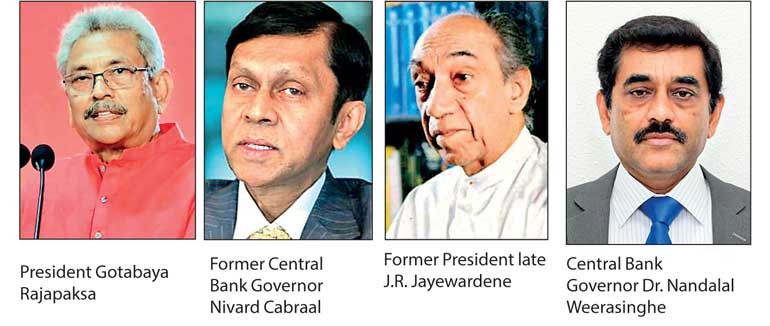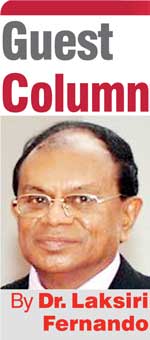Monday Apr 21, 2025
Monday Apr 21, 2025
Wednesday, 13 April 2022 00:00 - - {{hitsCtrl.values.hits}}

After artificially fixing the exchange rate in Sri Lanka for so many years (since 2001), whether the sudden floating of the rupee rate to dollar is a wise decision is altogether a different matter. However, because of this decision the dollar rate has jumped from Rs. 197/203 to 321/328 since this decision was taken on 9 March, just a month ago.
of the rupee rate to dollar is a wise decision is altogether a different matter. However, because of this decision the dollar rate has jumped from Rs. 197/203 to 321/328 since this decision was taken on 9 March, just a month ago.
Has Sri Lanka become a ‘low income’ country because of this decision, and other circumstances, is the first question that this short article raises. In 2019, as a mouthpiece of the Government the Central Bank announced, “Sri Lanka graduated to the upper middle income country status as per the World Bank classification of countries published in July 2019.”i On the other hand, the World Bank downgraded Sri Lanka to a ‘lower middle income’ country considering the currency crisis and inflation, in July 2020, much to the disappointment of the Government and economic bureaucrats.
Inaccurate classifications
It is the World Bank that classifies countries as ‘low income,’ ‘lower middle income,’ ‘upper middle income,’ and ‘high income’ countries whether those criteria are reasonable or accurate. Table 1 shows the measures that they use, simply said, based on the per capita GDP.
As I have raised this question previously, the income range for ‘low income’ or poor countries is arbitrary and excludes many countries who need international support from institutions and countries. The range could be up to $ 3,000 and not $ 1,036. Sri Lanka is only one country among them. There can be a tendency on the part of international organisations, including the World Bank and the IMF to avoid responsibility to help poor countries as those organisations are dominated by Western or rich countries.
Right to seek assistance
To seek assistance from international organisations and rich countries however is a right of poor and developing countries. On behalf of the people living in those countries, this right is absolutely a human right.
Strangely enough or ironically, the behaviour and attitudes of many elite politicians in poor and low-income countries go hand in glove with these elite politicians and bureaucrats in rich countries and international institutions. Sri Lanka is a very good examples and most of the arguments in this direction come from the ‘nationalists’ and ‘leftists.’
Before going into details of this matter, let me first answer the question whether Sri Lanka has now fallen into the pit of low-income or poor countries. Sri Lanka’s GDP or per capita GDP is calculated first based on rupees. Let us take an example.
According to the Department of Census and Statistics, Sri Lanka’s GDP on market prices in 2021 was Rs. (million) 16,809,309.ii Sri Lanka’s population is 22 million. Therefore, Sri Lanka’s per capita income was Rs. 764,059 million.
As of today, the dollar value of this per capita GDP is just $ 2,380, based on the floating rupee (1 Dollar = Rs. 321), irrespective of the Government’s ‘vision for prosperity’! The reasons are bad financial management, wishful thinking and power politics. The reasons apply not only to the present Government but to all past governments.
IMF assistance?
The second question that I want to raise is what is wrong in going to the IMF and seeking assistance? Sri Lanka joined the IMF in 1950 even before joining the UN (1955). One advantage the country has at present is ironically not seeking much assistance previously from this organisation meant to assist member countries (190 members now).
It was in 1965 that Sri Lanka first sought IMF ‘assistance’ and continued to do so until 2002 as a formality even without drawing the full amounts owed to the country under ‘Standby Arrangements.’ See this table.iii It was under J.R. Jayewardene that the country sought ‘Extended Fund Facility’ in 1979 due to the foreign exchange difficulties. But that amount had to be paid back in three years which raised much criticism. In 1988, the same administration sought ‘Structural Adjustment Facility’ again to be paid back in three years.
I happened to meet the IMF representative to South Asia/Sri Lanka in 1990 at a Norwegian friend’s place in Geneva (Inger Nordback) the guy’s name I cannot offhand now remember. He was one who appeared in picture with JR during a famous ‘Vap Magul’ festival. Our casual meeting led to some talk about ‘IMF conditions’ and he told me that the problem with Sri Lankan representatives was that ‘they don’t bargain but leave with dissatisfaction after meetings.’ I hope this is not and should not be the case today.
Sri Lanka has received the last ‘Extended Fund Facility’ from IMF in 2016 to the amount of $ 952,230,000 to be paid in 2020 and still 892,283,000 is outstanding. Perhaps this is understandable, given the COVID pandemic and other circumstances. Otherwise, Sri Lanka has a ‘clean slate’ thanks to the ‘nationalist and leftist’ antipathy against the IMF!
Debt restructuring
Let me touch on some other IMF matters. When Rajan Philips wrote ‘Mayhem in Mirihana; Shaken Gota is Home Under Curfew’ (Colombo Telegraph, 3 April), I posted the following comment and there were scathing attacks on me as usual!
“The declaration of curfew is acceptable to prevent further anarchy and violence today based on the experience at Mirihana and other places. However, this should not continue. The immediate root cause should soon be addressed. The government (whatever) should immediately negotiate with the IMF to obtain $ 10 billion to end the fuel crisis, energy shortages, essential imports, and loan repayments of this year. Then the unrest might subside. Debt restructuring can be done from next year. If the government is multi-partisan, it is very much better in negotiating with the IMF. There is no point in obtaining ad hoc loans from countries although those could be utilised later. It is already too late. IMF officials completed discussions with the government officials in December although the Report came out in February. This is April. Whatever the weaknesses or biases of the IMF, it is the main international mechanism to rescue countries under international monetary constraints. Undoubtedly, Sri Lanka must agree for strict conditions which could be negotiated. When you fall into a pit, you must escape from the same pit.”
I was looking at the economic side of the crisis and still maintain the same positions except the fifth sentence of the above quote: ‘Debt restructuring can be done from next year.’
Obviously, debt restructuring should start forthwith. Past governments, including the present, have irresponsibly depended on international sovereign bonds at higher rates of interest and purely on commercial conditions even with China. A poor country like Sri Lanka cannot afford that. The present debt obligations for this year appear to exceed $ 7 billion. Forex reserves at present however do not exceed 2 billion, necessary for even essential imports.
The Government has appointed a good three-member expert panel to advise and negotiate with the IMF. The appointment of the present Central Bank Governor is also commendable. While negotiating with the countries like India and China or institutions like the Asian Development Bank and the World Bank to postpone the debt repayments, if Sri Lanka could obtain around $ 10 billion from the IMF, some of the economic reasons for the present crisis can be ameliorated.
Political crisis
The present political mobilisations with Kumar David’s slogan ‘Go Gota Go’ are mainly political, of course based on economic and social reasons. However, to seek IMF assistance to resolve the economic crisis there should be some political stability. This is something Sri Lanka is lacking not only under the present Government, but it was there even under the last government.
The spontaneous protests from non-political sources at least have understood this calamity without supporting any political party. The question however is, what are the alternatives?
During the debates on the IMF report in Parliament, no MP on the Government side or in the Opposition never came up with a constructive proposal. Even Sajith Premadasa’s argument was to resolve the forex crisis acquiring money laundering revealed in the Pandora Papers. The gravity of the crisis was undermined. The debates were focused on personal attacks and trivial political matters.
The Opposition is now proposing a ‘no confidence motion’ on the Government and an impeachment against the President if the former is successful. On the other hand, the so-called ‘independents’ who broke away from the Government are proposing an ‘interim government’ until the economic crisis is resolved, and the country can hold elections. That kind of a government could include Ranil Wickremesinghe, M.A. Sumanthiran, and Harsha de Silva if not Sajith Premadasa. No Rajapaksa should be included except the President who should promise to leave politics within two years. Under such an interim government, President’s power should be curtailed. This could be the opening for changing the presidential system among other things.
Footnotes:
i13_Box_01.pdf (cbsl.gov.lk)
iiNational Accounts | Central Bank of Sri Lanka (cbsl.gov.lk)
iiiHistory of Lending Commitments: Sri Lanka (imf.org)
Discover Kapruka, the leading online shopping platform in Sri Lanka, where you can conveniently send Gifts and Flowers to your loved ones for any event including Valentine ’s Day. Explore a wide range of popular Shopping Categories on Kapruka, including Toys, Groceries, Electronics, Birthday Cakes, Fruits, Chocolates, Flower Bouquets, Clothing, Watches, Lingerie, Gift Sets and Jewellery. Also if you’re interested in selling with Kapruka, Partner Central by Kapruka is the best solution to start with. Moreover, through Kapruka Global Shop, you can also enjoy the convenience of purchasing products from renowned platforms like Amazon and eBay and have them delivered to Sri Lanka.
Discover Kapruka, the leading online shopping platform in Sri Lanka, where you can conveniently send Gifts and Flowers to your loved ones for any event including Valentine ’s Day. Explore a wide range of popular Shopping Categories on Kapruka, including Toys, Groceries, Electronics, Birthday Cakes, Fruits, Chocolates, Flower Bouquets, Clothing, Watches, Lingerie, Gift Sets and Jewellery. Also if you’re interested in selling with Kapruka, Partner Central by Kapruka is the best solution to start with. Moreover, through Kapruka Global Shop, you can also enjoy the convenience of purchasing products from renowned platforms like Amazon and eBay and have them delivered to Sri Lanka.